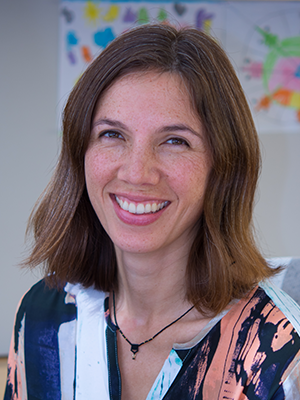From Axon Damage to Disease: Common Pathways in Neurodegeneration
- Claire E. Le Pichon,
PhD, Head, Unit on the Development of Neurodegeneration - Hanna Silberberg, MA, Biologist
- Stefano Antonucci, PhD, Visiting Fellow
- Jorge Gomez Deza, PhD, Visiting Fellow
- Snehal Mahadik, PhD, Visiting Fellow
- Sasha Stavsky, PhD, Visiting Fellow
- Mor Alkaslasi, BS, Graduate Student
- Josette J. Wlaschin, MSc, Graduate Student
- Vanya Bhat, BS, Postbaccalaureate Fellow
- Peyton Lee, BS, Postbaccalaureate Fellow
- Eliza Lloyd, BS, Postbaccalaureate Fellow

Our work is dedicated to advancing our understanding of common molecular and cellular mechanisms of neurodegeneration, with the ultimate goal of developing treatments for neurodegenerative diseases and even preventing them. The hypothesis driving our work is that common mechanisms are responsible for neurodegeneration during development and in aging. One focus is on mechanisms of stress-response pathways in neurons, such as the evolutionarily conserved axon-damage signaling pathway under the control of DLK (dual leucine zipper kinase; MAP3K12). A second approach is to understand fundamental differences between vulnerable and resilient populations of neurons in models of acute injury and in chronic disease. The lab uses the mouse and human iPSC–derived neurons as model systems.
Elucidation of mechanisms of axon-damage signaling in human neurons
DLK is an essential player in the axonal response to neuronal injury. This gene and others that act within the same pathway have independently come up in unbiased screens for regulators of neuronal regeneration and degeneration in different species. It is known that DLK can promote axon degeneration, neuronal cell death, and regeneration. However, the exact mechanisms by which it acts within neurons is incompletely understood. To identify regulators and substrates of DLK function, we study DLK localization, trafficking, and interactors in human iPSC–derived neurons. We are also elucidating mechanisms of axon degeneration in human neurons [Reference 1], as well as downstream mechanisms of DLK signaling by studying the function of genes we identified as hits from CRISPR inhibition survival screens. We found that DLK can initiate an apoptotic cascade of mitochondrial fission in the axon after injury. Using live confocal imaging of human axons, we found that, upon an injury to the axon, DLK sets off a wave of apoptotic mitochondrial fission that travels from the damage site back to the cell body, leading to axon degeneration and neuronal cell death. The retrograde mitochondrial fission requires DLK–dependent phosphorylation of the GTPase dynamin–related peptide 1 DRP1 [Reference 2].
Understanding fundamental differences between vulnerable and resilient populations of spinal motor neurons in disease
We individually profile transcriptomes of spinal-cord motor neurons in healthy mice and disease models to track the transcriptomic alterations undergone by cells during disease progression. Previously, we published a single-cell transcriptomic atlas of adult mouse spinal motor neurons [Alkaslasi MR et al. Nat Commun 2021;12:2471]. Previously, very few spinal motor neurons (MNs) had been resolved at the single-cell level, both because they are relatively rare among all spinal cells, and because they do not survive single-cell isolation protocols. We were able to succeed by combining two strategies: (1) enriching for spinal MNs using a Chat-Cre line; and (2) capturing single nuclei, which are more robust than whole cells. We comprehensively defined all the subtypes of adult mouse MNs that exist. The data from this study can be browsed at http://www.spinalcordatlas.org and are also available at https://seqseek.ninds.nih.gov. We also contributed to similar studies in human tissue [Reference 3]. We are now applying this technique to interrogate transcriptional changes that arise in motor neurons during disease progression. Detecting pathological change in individual neurons over time will yield key insights because it is known that specific subpopulations of motor neurons are more vulnerable than others to disease. We are comparing the transcriptomes of resilient motor neurons with those of vulnerable motor neuron types across many time points.
In parallel studies, we are developing and characterizing new models of juvenile onset motor neuron disease. The work gave rise to a recently published collaboration in which we provided in vivo proof of principle that it is possible to specifically target motor neurons that are undergoing pathological change, using a gene-therapy approach that remains silent in healthy cells [Reference 4]. The strategy takes advantage of the unique biology of TDP-43, a splicing repressor of many genes, which becomes dysregulated in a subset of neurons in ALS and other neurodegenerative disorders.
Additional Funding
- Packard Center - Johns Hopkins
Publications
- DLK-dependent axonal mitochondrial fission drives degeneration after axotomy. BioRxiv 2024 2023.01.30.526132v2
- Local production of reactive oxygen species drives vincristine-induced axon degeneration. Cell Death Dis 2023 14(12):807
- Creation of de novo cryptic splicing for ALS and FTD precision medicine. Science 2024 386 (6717):61–69
- A reproducible signature of cytoskeletal and ALS-related genes in human motoneurons. Neuron 2023 111:3742–3744
Collaborators
- Pietro Fratta, MD, PhD, University College London, London, United Kingdom
- Ariel Levine, MD, PhD, Spinal Circuits and Plasticity Unit, NINDS, Bethesda, MD
- Michael E. Ward, MD, PhD, Inherited Neurodegenerative Diseases Unit, NINDS, Bethesda, MD
Contact
For more information, email claire.lepichon@nih.gov or visit https://www.nichd.nih.gov/research/atNICHD/Investigators/lepichon.

